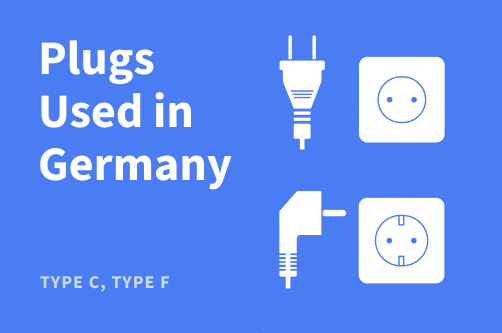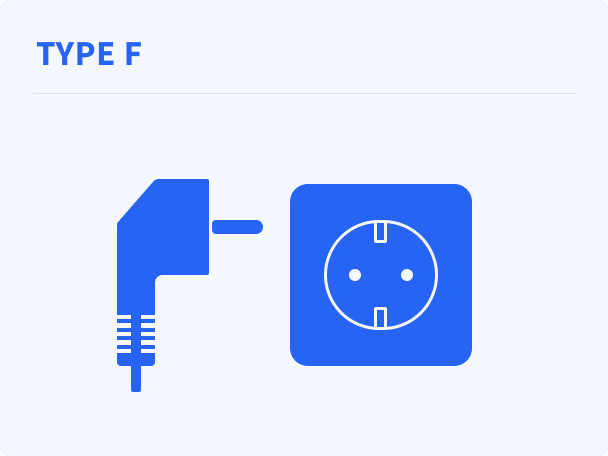Travel essentials for women don’t just include standard packing lists–they should reflect the mo...
Travel Guides
Traveling to Germany? You’ll need a plug adapter for Type C or Type F sockets and devices that support 230V. This guide covers everything you need to charge safely and stay connected during your trip.


Planning a trip to Germany? While you’re busy mapping out your itinerary and reserving accommodations don’t overlook one crucial aspect of your travel preparations — electrical compatibility.
Understanding the types of plugs you'll encounter in Germany is essential for ensuring that your devices are charged and ready to use.
That said, let’s take a closer look at Germany’s plug types and electrical standards.
In Germany, you'll primarily find two types of plugs: Type C and Type F. Being aware of these plug types is essential for keeping your mobile phones, cameras, and other devices like laptops and tablets charged and ready to use during your travels.

Known as the "Europlug," the Type C plug is named for its widespread adoption across European countries, making it the most common plug type on the continent. It features two round pins that measure 4.0 mm in diameter and are spaced 19 mm apart.

Often referred to as the "Schuko" plug, Type F bears a resemblance to Type C, although it includes grounding clips on either side for improved safety. This grounding mechanism not only provides added stability in the socket but also helps reduce the risk of electrical issues,
In addition to understanding plug types, it's essential to know that Germany operates on a standard voltage of 230V and a frequency of 50Hz.
If you’re traveling from countries like the United States, where the standard voltage is 120V, it’s vital to check whether your devices are compatible with the higher voltage.
Most modern chargers and electronic devices are designed to accommodate a range of voltages (typically labeled as 100–240V). If your device only supports 120V, using it in Germany may result in damage.
Finding the right adapter can save you from unnecessary headaches during your trip. While you can purchase adapters at local electronics stores or travel shops in Germany, it’s often easier to buy one online before you leave.
Here are some excellent options available online:
This versatile travel plug adapter is compatible with a variety of European countries, including Belgium, Germany, Spain, Italy, and France. It is designed to accept standard North American 2 or 3-prong flat pin plugs, ensuring a reliable connection for electronic devices throughout Europe.
The adapter converts one European Type C socket into four American AC outlets and four USB charging ports, with a maximum capacity of 2500W (250V, 10A), enabling the simultaneous charging of multiple devices without blocking adjacent outlets.
Its lightweight and foldable design facilitates easy transport, allowing it to fit seamlessly into bags or pockets. Ideal for charging mobile phones, tablets, cameras, and other devices while traveling.
This foldable international power plug adapter features a 2-in-1 design with both Type C and Type L plugs, ensuring compatibility with a wide range of European countries, including Spain, Italy, France, and Germany. The design facilitates easy switching between a two-prong EU plug and a three-prong Italian plug.
As a 4-in-1 power charger, the adapter accepts standard North American 2 or 3-prong flat pin plugs and includes two USB-A ports and one USB-C port, allowing for the simultaneous fast charging of up to four devices.
Certified for safety with CE, EMC, ROHS, FCC, and LVD standards, this travel accessory incorporates multiple safety features, including Smart IC technology, fireproof PC materials, and a grounded prong. It supports devices operating within a voltage range of 110V-240V.
This adaptable travel adapter kit includes both Type C and Type G plugs. The 3-in-1 wall outlet adapter is designed for use throughout Europe and accommodates standard North American 2 or 3-prong flat pin plugs, supporting a maximum output of 2500W (250V, 10A).
Equipped with dual USB ports, the adapter provides a maximum charging capacity of 2.4A for powering various devices, including cell phones and tablets. An indicator light indicates when the adapter is in use.
The Type C plug is compatible with a majority of European countries, while the Type G plug caters to the UK and several other overseas destinations.
This European plug adapter is designed for use in countries such as Spain, France, Germany, Greece, Turkey, and Portugal. It facilitates the connection of up to four devices simultaneously through a grounded outlet, a non-grounded outlet, a USB-A port, and a USB-C port, providing a maximum output of 18W.
Featuring a standard Type C plug (CEE 7/16), the adapter accommodates North American 2 or 3-prong flat pin NEMA 5-15 plugs, including polarized options. It includes smart voltage USB ports that support Quick Charge (QC) and Power Delivery (PD) technology, enabling fast charging for compatible USB devices while traveling.
Measuring just 1.18 x 1.78 x 2.89 inches and weighing 3.2 oz, this adapter supports a maximum output of 10A and voltage up to 250V, ensuring reliable performance for a variety of electrical devices.
Before traveling to Germany, it’s important to determine whether a voltage converter is necessary alongside your plug adapter. While a plug adapter allows the connection of your devices to different socket types, it does not alter the voltage.
If your devices are not compatible with the local voltage of 230V, a converter will be required to avoid damage.
If you’re bringing along high-power appliances like hair dryers or straighteners, check their specifications. If your appliance is dual voltage (like 100–240V), a plug adapter is sufficient.
However, if it only supports 120V, a voltage converter is a wise investment to protect your devices from potential damage.
If you love to travel, becoming familiar with the different plug types around the world can be incredibly helpful. Here’s a quick look at some of the most common plug types you might encounter:
See what different plug types look like in the below infographic:

1. What are the risks of using an incompatible plug adapter in Germany?
Using an incompatible plug adapter can lead to device malfunctions, overheating, or even electrical fires. It's crucial to ensure that the adapter matches both the plug type and the voltage requirements of your devices.
2. Do German hotels provide plug adapters, or should I bring my own?
Many hotels in Germany may not provide plug adapters, so it’s advisable to bring your own. While some may have adapters available for guests, relying solely on hotel-provided equipment can be risky.
3. Are there any commonly used appliances that require special adapters in Germany?
Certain appliances, such as hair dryers, curling irons, or espresso machines, may require specialized adapters or converters due to higher wattage. It’s essential to check the requirements for each device before traveling.

